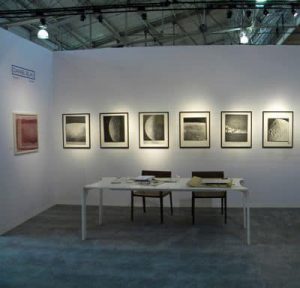FAIRS
September 15, 2011 — September 18, 2011
186.283 mps
An exhibition of rare NASA photographs 1965 –1981.
Two great achievements in science have given us some of the most striking and memorable photographic images of the 20th century. The iconic pictures of the rising mushroom cloud were a visual testimony to the success of atomic tests. Space exploration gave us unforget-table views of Earth and Moon as seen from space (Apollo 8), as well as “Buzz” Aldrin’s footprint in Lunar soil. These pictures have become part of our visual memory. They are not simple snap-shots by an amateur, taken with a Kodak Box, but the result of the combined efforts of tens-of-thousands of workers and scientists.Some of these astronomically costly missions, Luna 3 for example, produced very few useful photographs, making each print absurdly expensive and ultimatly precious. These grainy pictures of the Moon from afar are strangely remeniscent of the Shroud of Turin and induce the same sense of wonder. Other missions resulted in an endless stream of photographs both in color and black and white, in negative and positive (Apollo XI). From 1945 through the early 1960’s the USA “flooded” the world’s press agencies with thousands of images of atomic tests. They were photographed in every possible way, keeping the audience continuously in awe; from the ground, from the air, under water, through a periscope, next to a zeppelin, at night, during the day or even “by invitation only.” As the Space Race became more of the public and media focus, photographs taken in space replaced the explosion pictures. Now it was the blast-off, the blue Earth, two space ships meeting in the void above Earth (Gemini), photos radioed back from rockets moments before impacting the Lunar surface (Ranger), pictures taken by radio controlled video cameras on the Moon, radioed back to Earth and reassembled here (Surveyor). One of the unmanned missions (Orbiter) asked for a complete dark room to be shot into space. It was a kind of photo-booth taking photos of the moon while orbiting it, developing the film, scanning the negative and radioing the data back to Earth. Here the signal was again transferred onto negative film from which the positive pictures were printed. The Orbiter probe eventually crashed on the Moon, thus destroying the original negatives. The successful landing of Apollo XI on the Moon changed all that; from July 1969 on we became used to focused and detailed photographs in colour. True, the pictures we received while the astronauts were still “out there” had the low quality of wire-prints. On the other hand, the Kodak films they brought back were crisp and “juicy” like tourist photos from Rome, the Grand Canyon or Palm Springs. The images of the atomic cloud, as well as those of the astronauts on the Moon were “tools” of propaganda for the American dream, demonstrating might and offering hope. In San Francisco at SF20/21, we are presenting a selection of significant vintage NASA photographs. Some of them are unique surviving examples of the Sisyphean task of assembling thousands of small photographs to fairly large mosaics of Moon-scapes (Surveyor). Others are important for their size or simply as rare survivors from a once important archive of prints that, within the last fifty years was dispersed, perhaps on account of digitisation or because it became technologically antiquated. Today we treasure these vintage prints for their artistic quality and as permanent visual evidence of a time when the future seemed so close.
Opening: September 15
Exhibition: September 16 –18, 2011
Festival Pavilion at Fort Mason Center San Francisco, CA 94123
Telephone at the booth: +49 / 172 / 74 84 999






 +49 89 29 73 42
+49 89 29 73 42